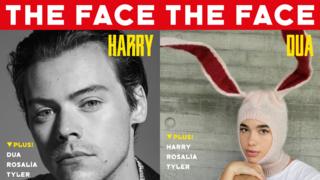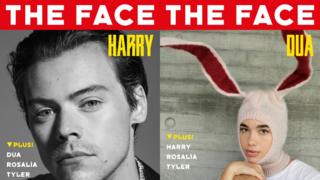The Face: Is 2019 the time to launch a new magazine?
After 15 years out of print, the pop culture and fashion mag is back with hopes of gaining new fans. …

 Image copyright The Face
Image copyright The Face “Wow, you’re going to the launch of the new Face magazine? I’m so jealous!”
That was the response of my dad when I told him what I was doing for work, and it totally took me by surprise.
His face lit up as he told me about buying The Face for the first time in May 1980, and he even had the first 10 editions on hand to show me.
But as someone in their 20s, the magazine really doesn’t mean much to me – it went out of print in 2004 when I was 10 years old.
In its heyday, The Face came out every month and would feature interviews with the biggest artists in the UK and US, along with showcasing fashion trends, club culture and cutting-edge photography.
Cover stars included everyone from David Bowie, Duran Duran and Oasis to actor Luke Perry and Naomi Campbell.
An unknown Kate Moss appeared on the cover in 1990 in a move that has been widely seen as the one that launched her career as a supermodel.
So as the magazine relaunches this month, will it succeed in capturing a whole new generation of pop culture and fashion lovers?
“The time felt right for a magazine that offered a certain amount of curation when the internet offers endless scrolling and endless information,” The Face’s deputy editor, Matthew Whitehouse, tells Newsbeat.
“Hopefully everybody will want to read it, ideally you want teenagers to want to buy it and at the same time you want it to be interesting to people who aren’t teenagers,” he says.
The newly launched magazine, which came out on Friday and will be published every quarter, has four cover stars – Harry Styles, Tyler the Creator, Dua Lipa and Rosalia.
They all have fairly millennial followings, as do England goalkeeper Jordan Pickford and Liam Gallagher, whose interviews also feature amongst the 300 pages of content.
One of the big questions for Matthew is how inclusive this magazine is going to be and whether it will have an appeal that reaches beyond London.
“I’m from the northwest of England and working class,” he says.
“Something I’m incredibly proud of about this magazine is that it features not one London-based musician in it.”
It’s a good claim – but slightly ignores the fact that one of the cover stars, Dua Lipa, has spent most of her life in London.
He says none of the editorial team at The Face are from London and that means everyone is “conscious of appealing to people outside of the capital”.
“I remember being 15 and reading these trendy magazines and thinking not how do I get my foot in the door, but where even is the door, so it’s very important to me to have those voices in there.”
So with that in mind, and for everything positive he had to say, the launch party felt more high fashion than high street.
It was in collaboration with designer shoe brand Louboutin and London Fashion Week, taking place in an exclusive Soho location.
People were queuing down the street just to get in, and once inside, the packed basement was filled with outfits that looked fresh off the catwalk.
It felt removed from the magazine’s “something for everyone” vibe and more like a party where your name wasn’t on the list.
For former magazine editor and Goldsmith’s Uni lecturer Kathryn Blundell, she has a different perspective, and worries whether The Face will actually attract young people.
“It’s interesting that The Face has chosen to pitch itself to a younger audience given that its original readers – now in their 40s and 50s – are more established magazine buyers,” she tells Newsbeat.
“The Face as a brand doesn’t mean anything to people in their 20s, even when you take into account renewed interest in all things 90s.
“And nearly £10 an issue is a big ask for young people, especially given it’s a crowded market with brands like Dazed that are well established.”
It’s difficult to ignore what’s happening in the wider publishing industry in the UK too – last week Marie Claire announced it was closing its print edition, following in the footsteps of NME and Glamour.
“What this launch signals to me is that print still adds kudos to a brand,” she says.
“When magazine brands have gone digital only, they don’t last long. People forget about them and the brands feels less relevant and old fashioned.
“Whether younger people feel the same way is another matter though.
“Most aren’t in the habit of buying magazines now, and things like social media and apps that curate content fill a gap that magazines used to occupy. “
Kathryn does say though that from looking at The Face’s content, it seems “accessible” to a wide audience and doesn’t look “overly artsy”, which could help to draw in a larger audience.
“What I often find when I’m looking at magazines in this market is that they focus on ‘new’ people, underground names and subcultures, so you have to be really in the know to get it.
“No one wants to think they haven’t got their fingers on the pulse. I think The Face has navigated this well – it’s got the big names that sell magazines and everything presented in an accessible style.”
Follow Newsbeat on Instagram, Facebook, Twitter and YouTube.
Listen to Newsbeat live at 12:45 and 17:45 weekdays – or listen back here.




